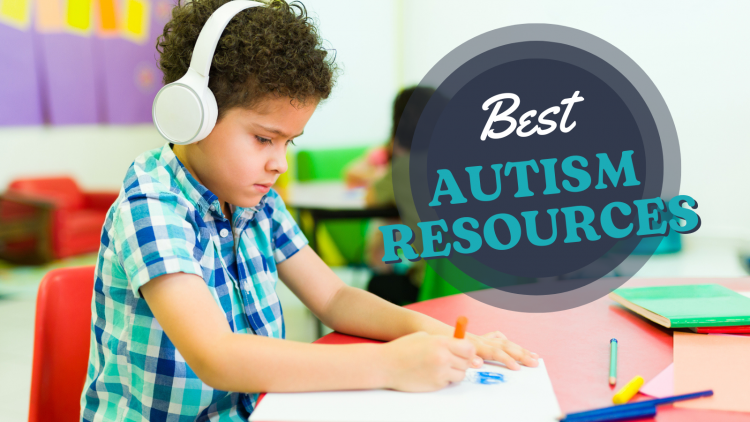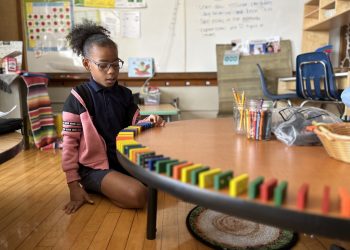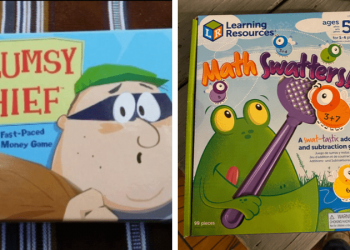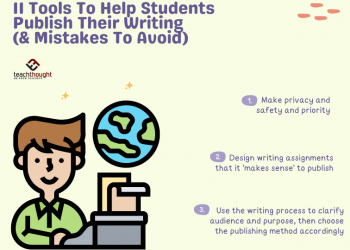According to the CDC, about 1 in 44 children is diagnosed with Autism Spectrum Disorder (ASD). That means most educators will encounter some of these students in their classrooms on a regular basis. Use these autism resources for teachers to better understand your students, and make your classroom the best possible learning space for them.
Jump to:
Resources for Learning About Autism
Teaching children with autism effectively requires a strong understanding of the condition itself. These autism resources for teachers provide the background knowledge you need to help these students do their best.
OAR Autism Curriculum in a Box
The Organization for Autism Research offers a variety of teacher tools and resources, but we’re most impressed by the robust Curriculum in a Box. All the materials are available online, but they’ll also send you a free hard copy. You get a fully scripted professional development presentation with videos, slides, and notes. It also includes a training manual, two Life Journey Through Autism guidebooks, and an educator’s reference sheet.
NIMH: Autism Spectrum Disorder
The National Institute of Mental Health (NIMH) has an excellent overview of autism, including its signs, symptoms, treatments, and therapies. They also provide information about ongoing research studies that are looking for participants. This is a good place to start if you need basic information about ASD.
Autism Speaks
Autism Speaks is dedicated to promoting solutions—across the spectrum and throughout the life span—for the needs of individuals with autism and their families. They host the yearly Autism Speaks Walk, the largest autism fundraising event in the world. Their site has a nice selection of autism resources, including an Education and Autism section that’s helpful for both teachers and parents.
Autism Society
The Autism Society strives to empower individuals with autism and their families to make informed decisions in the planning and delivery of individualized, evidence-based services and support. Check out their Education page for lots of autism resources for teachers and schools.
Webinars at the Autism Research Institute
The institute conducts regular free webinars on a variety of topics, some of which are very helpful for educators. Join them live, or watch recordings of sessions like Creating a Well-Structured Classroom for Autism or Back-to-School Strategies for Autism.
Understood.org Autism Resources
Understood is dedicated to helping those with thinking and learning differences stay on positive paths throughout life’s journeys. They have lots of information on neurodivergence, learning disorders, and other challenges students face, and they specialize in helping others provide support. Plus, many of their resources are available in both English and Spanish.
7 Things Your Students With Autism Wish You Knew About Them
Find out what these kids want you to know from a longtime SPED teacher, who not only works with autistic students but also has an autistic spouse. One important tip: “Just because they’re not looking at you doesn’t mean they’re not listening.” See them all at the link.
Autism Tuned In
Here’s another resource for learning about autism from OAR. This one’s meant for teaching students about their peers with autism. The videos and online games are fun and interactive and make excellent SEL activities.
Autism Books for Teachers and Classrooms
Whether you want to build a resource library for yourself or your school or find meaningful ways to share the stories of neurodivergent kids with your students, these book lists have what you’re looking for.
12 Essential Books for Teaching Kids With Autism
Use these for professional development, and build a resource library to refer back to throughout your teaching career. The list includes titles like Ellen Notbohm’s Ten Things Your Student With Autism Wishes You Knew and Carol Gray’s The New Social Story Book.
23 Books About Autistic Kids for All Students
Books about autistic kids are important for all classrooms. They let neurodivergent kids see themselves in literature, plus they help every student develop appreciation and empathy for various people’s strengths, personality traits, and challenges. This roundup has picture books like The Girl Who Thought in Pictures, middle grade reads like Get a Grip, Vivy Cohen!, and young adult picks like When My Heart Joins the Thousand.
15 Books for Tweens That Celebrate Neurodiversity
Autism is one type of neurodiversity, and kids with autism may have other types as well. This collection of books explores the strengths and challenges of living with neurological differences. Find titles like Anything But Typical and Rain Reign.
Autism Tools and Strategies for the Classroom
Source: AutismClassroom.com
Need ideas to help kids with autism succeed in school? Try these top resources.
NPDC Evidence-Based Practices
The National Professional Development Center on Autism Spectrum Disorder focuses on evidence-based practices to help those with autism succeed. They’ve identified the strategies and tools that are proven to work, and created guides to understanding and implementing them. Tools include Differential Reinforcement, Social Skills Training, and dozens more.
NEA Teaching Students With Autism Guide
Produced by the National Education Association, this comprehensive printable guide is chock-full of some of the most up-to-date information on teaching students with autism. You’ll learn about creating a welcoming classroom, planning individualized supports, and more.
How To Build a Meaningful IEP for Autism
Educators may be asked to help create IEPs for students with autism. This site has detailed information on helpful accommodations, including samples. It’s a must-read before going to an IEP meeting.
Autism Classroom News & Resources
Dr. Chris Reeve helps educators connect with students to build successful relationships, prevent challenging behavior, and improve outcomes. She focuses on practical training, tips, and printed or digital resources designed for the real-world classroom. You’ll find a blog, podcast, free resources, and also a Teachers Pay Teachers shop with materials for purchase.
CDC: Information on Autism Spectrum Disorder for Educators
From Facts About ASD to a complete “Go Out and Play!” kit for early educators, the CDC has plenty of useful information for teachers and schools. Teachers will especially appreciate the advice on talking to parents about suspected developmental delays or challenges.
AutismClassroom.com
The educator who runs this website specializes in helping teachers organize and run their autism classrooms. Her site is full of free resources and teaching tips. You can also buy materials from her Teachers Pay Teachers store that are specifically designed to help with the skills and strategies these students need.
Why Safe Spaces Are Critical in Today’s Classrooms
Kids can’t learn when they don’t feel safe. When their senses are heightened, a regular school classroom can overwhelm them in no time. Safe spaces serve every kind of student. For some, the space might give them a brief pause from a tough day. For others, it can be so much more. Learn more at the link.
How To Create and Use a Calm-Down Corner in Any Learning Environment
Calm-down corners are a popular tool in classrooms these days. Teachers recognize that kids, like adults, have a lot of feelings and emotions to process throughout the day. Sometimes it’s all too much, and the result can be bad behavior. A calm-down corner gives kids a place to recenter and refocus so they can rejoin the learning. Learn how to build and effectively use one in your classroom.
30 Must-Try Sensory Room Ideas for Schools
Have room for more than just a corner? Try a whole room! Many schools that have created a sensory room (or a sensory space) have noticed a dramatic decrease in behavior referrals. Find all the ideas you need in this article.
Zones of Regulation Activities To Help Kids Manage Their Emotions
Zones of Regulation, a curriculum developed by Leah Kuypers, an OT and autism resource specialist, helps kids understand and learn to manage their emotions. Rooted in cognitive behavioral therapy, it is a framework that uses four colors—blue, green, yellow, and red—to help students identify their feelings and levels of alertness. Learn more about the Zones of Regulation and find classroom activities to teach the concept.
How Teachers Can Support Twice Exceptional Students
Twice exceptional students, or 2e students, are learners who are identified as exceptionally bright but who also have disabilities (for example ADHD, mild autism, dyslexia, or other learning or behavioral challenges) that need specialized attention. The dichotomy of 2e students’ abilities makes it challenging for the average classroom teacher to provide an effective and appropriate education. Discover eight ways teachers can support twice exceptional students.
National Autism Resources
Looking for a place to buy some of the intriguing tools others use in their classrooms? This shopping site has everything from life-skills workbooks to fidget toys, weighted vests to pencil grips.
Have we missed any of your favorite autism resources for teachers? Come share and ask for advice on the WeAreTeachers HELPLINE group on Facebook.
Plus, check out 8 Art Therapy Activities To Help Kids Identify and Manage Their Feelings.
Source by www.weareteachers.com










